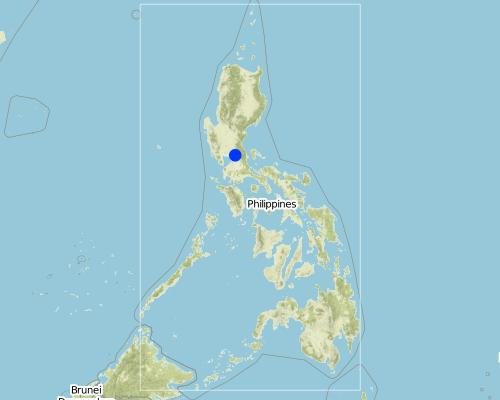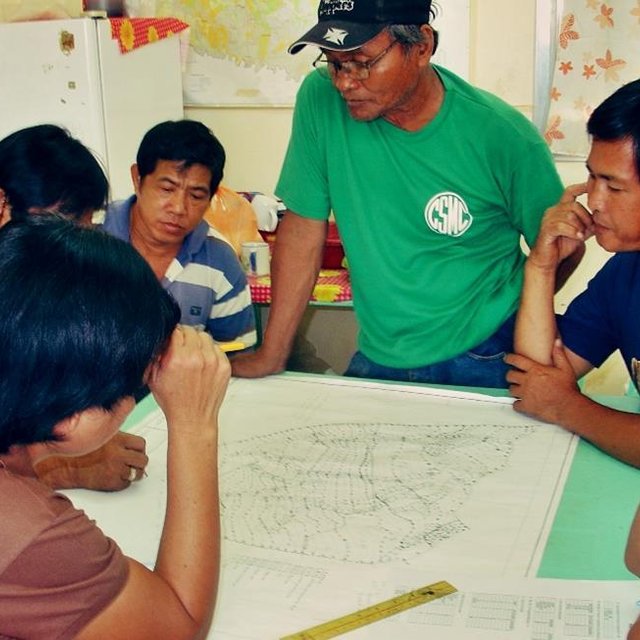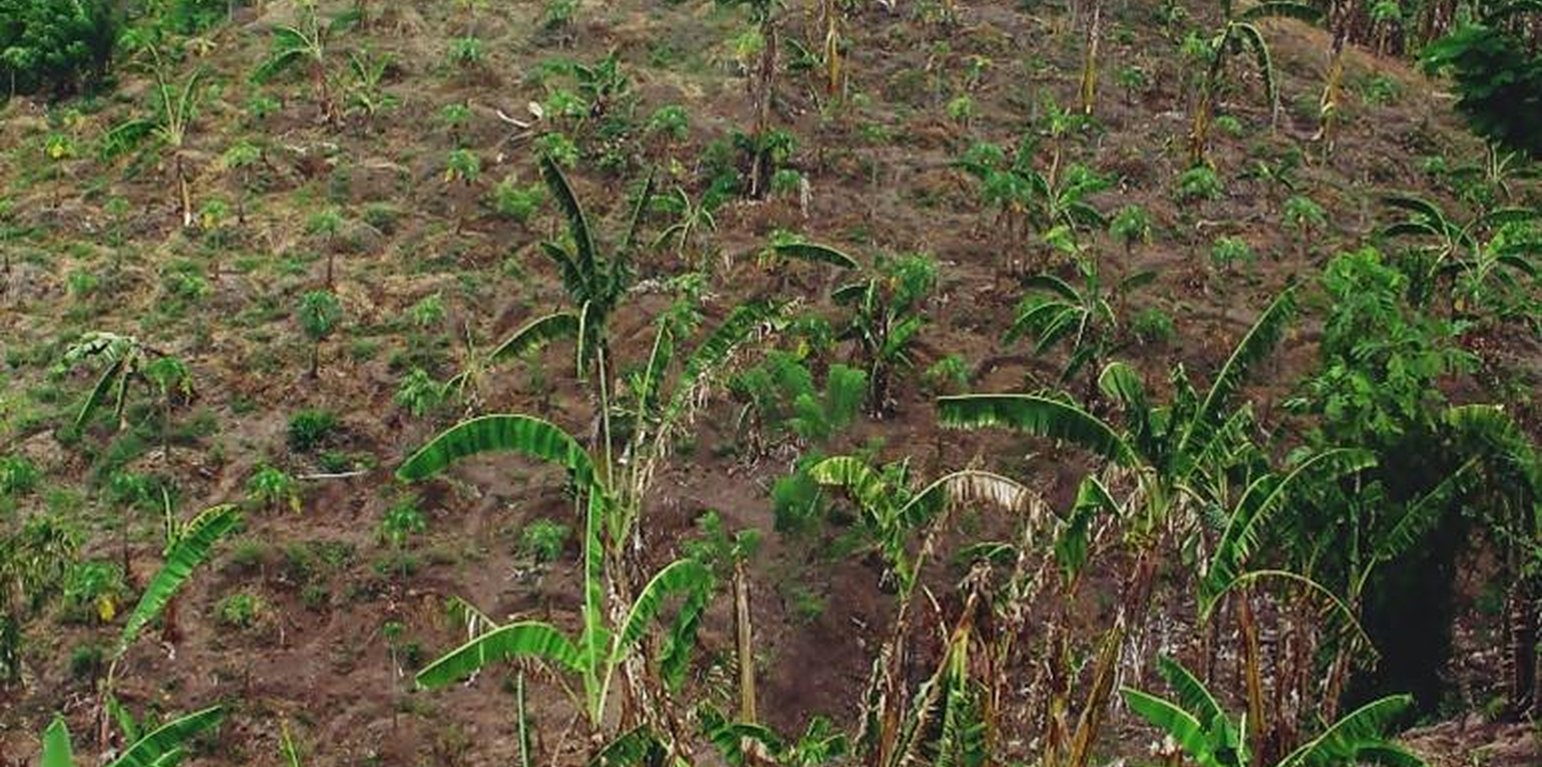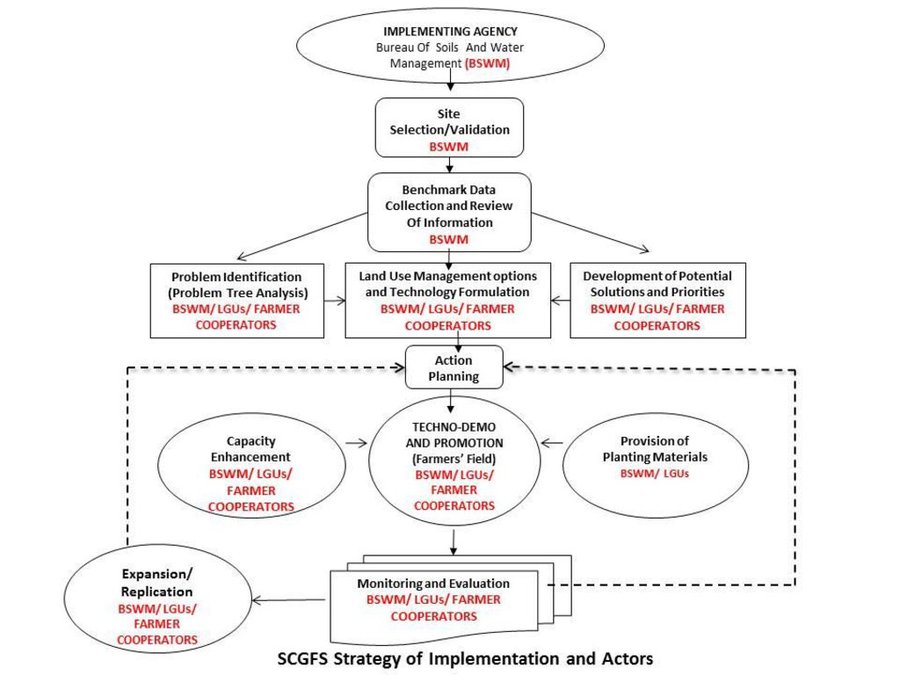Soil Conservation Guided Farm System
(Филиппины)
SCGFS, Guided Farm, Guided Farm Project
Описание
Soil Conservation Guided Farming System (SCGFS) is a land use management approach that integrates technologies: terracing, agro-pastoral technology, multi-storey cropping, and contouring within the socio-economic and bio-physical limitations of upland areas for optimum development of soil and water resource in a sustainable manner.
Generally, SCGFS aims to promote sustainable land use management that provides agricultural livelihood while protecting and maintaining environmental sustainability in the upland areas of the country. Its specific objectives: (1) Establish community-based and farmer-managed techno demo farms cum learning centers on soil and water conservation in marginal uplands and watersheds of Small Scale Irrigation Projects (SSIPs); (2) Promote and disseminate effective soil and water conservation approaches and technologies for broader adoption; and (3) Develop a strong linkage and partnership among local stakeholders and cooperators to protect our upland resources and watersheds.
Participatory Approach amongst stakeholders as spearheaded by the Bureau of Soils and Water Management (BSWM) through the Soil Conservation and Management Division (SCMD)
Stages of implementation: (1) Coordination with the Local Government Units (LGU) and consultation with farmers; (2) Memorandum of Agreement (MOA) preparation; (3) Reconnaissance survey (a. Site selection/ identification b. Dialogue with farmer cooperators); (4) Field Survey/Ground Truthing (Topographic survey, Land Resources survey); (5) Maps Preparation( Topographic Map, Soil Map, Land Use Map, Slope Map and Erosion Map); (6) Preparation of preliminary Farm Development Plan; (7) Presentation of Farm Development Plan to the LGUs and Farmer Cooperators (Discussion, Revision/modification); (8). Preparation of Project Study Report (Final Farm Development Plan); (9) Institutional Development/ Capacity Building; (10) Implementation Stage / Farm Development; (11)Conduct of season long farmer field school; and (12) Monitoring and Evaluation including Operation and Maintenance.
Role of stakeholders: A. Bureau of Soils and Water Management (BSWM):
1. Provide the over-all direction in the preparation of plans and programs for the implementation of soil and water conservation through the SCGFS;
2. Provide technical support and assistance in the promotion and implementation of soil and water conservation and in the conduct of capacity building activities (i.e. in terms of training modules and resource persons);
B. Partner agencies/institutions (e.g. LGUs and other concerned agencies):
1. Prepare and endorse request to the BSWM for the establishment of SCGFS as demo farm of soil and water conservation technologies;
2. Provide technical support and assistance to the co-operators in the conduct of field survey and investigation, preparation of soil conservation farm plan, establishment of the SCGFS, and undertaking the necessary training activities;
3. In coordination with BSWM, assist the co-operators in availing necessary farm inputs and facilities for the establishment of the SCGFS; and
4. Undertake monitoring and assessment of operation and maintenance of established SCGFS to immediately address on-farm problems.
C. The Farmer Cooperators (i.e. interest groups/individuals):
1. Signify their interest to establish soil and water conservation demo farm through formal request to the BSWM;
2. Be willing to provide their own resources in the establishment of the demo farm;
3. Provide support and assistance to BSWM in the conduct of field survey and investigation;
4. Act as extension agents in the local community to disseminate soil and water conservation technologies with the demo farm as the community learning center.
Местоположение

Местоположение: Bulacan, Филиппины
Географическая привязка выбранных участков
Дата ввода в действие: 2002
Дата завершения: н/п
Тип Подхода
-
традиционная/ местная система землепользования, используемая коренным населением
-
недавняя местная инициатива/ инновация
-
в рамках проекта/ программы

Farm Planning (Soil Conservation and Management Division Staff)
Цели подхода и благоприятные условия для его реализации
Главные цели/ задачи Подхода
SCGFS aims to promote sustainable land use management that provides agricultural livelihood while protecting and maintaining environmental sustainability in the upland areas of the country. Its specific objectives: (1) Establish community-based and farmer - managed techno demo farms cum learning centers on soil and water conservation in marginal uplands and watersheds of SSIPs; (2) Promote and disseminate effective soil and water conservation approaches and technologies for broader adoption; and (3) Develop a strong linkage and partnership among local stakeholders and cooperators to protect our upland resources and watersheds.
Условия, содействующие применению Технологии/ Технологий в рамках Подхода
-
Наличие/ доступность финансовых ресурсов и услуг: Support from BSWM, Department of Agrarian Reform (DAR) & LGUs; Income Generating Technologies
-
Институциональные условия: Organized farmers association
-
Осведомленность в области УЗП, доступность технической поддержки: Capacity building, Farmers Field School
-
Объем работ, доступность рабочей силы: Provide additional labor
Условия, затрудняющие применение Технологии/ Технологий в рамках Подхода
Участие и распределение ролей заинтересованных сторон
Заинтересованные стороны, участвующие в реализации Подхода, и их роли
| Какие заинтересованные стороны/ организации-исполнители участвовали в реализации Подхода? |
Перечислите заинтересованные стороны |
Опишите роли заинтересованных сторон |
| местные землепользователи/ местные сообщества |
|
|
| эксперты по УЗП/ сельскому хозяйству |
|
|
| местные власти |
Local Government Unit |
|
Ведущая организация
Land user groups
Участие местных землепользователей/ местных сообществ на разных стадиях реализации Подхода
нет
пассивное
внешняя поддержка
интерактивное
самоорганизация
инициирование/ мотивация
BSWM initiates the establishment of the project. Field surveys i.e site validation, topographic surveys etc. are conducted by BSWM technical staffs.
планирование
Planning involves both BSWM and LGUs, technology/ies to be established is/are dependent on the biophysical limitation of the area and the needs of farmer cooperators.
выполнение
Implementation of the project requires participatory involvement amongst stakeholders.
мониторинг/ оценка
BSWM, LGUs and farmer cooperators are responsible in the monitoring and evaluation of the established technologies, these will ensure continued adaptation of the technology.
Схема реализации Подхода
SCGFS Stages of Implementation and Actors
Принятие решений по выбору Технологии УЗП
Решения принимались
-
исключительно землепользователи (по собственной инициативе)
-
в основном землепользователи при поддержке специалистов по УЗП
-
все участники как часть процесса совместных действий
-
преимущественно специалисты по УЗП после консультаций с землепользователями
-
исключительно специалисты по УЗП
-
политики/ руководители
Принятие решений было основано на
-
анализ подробно описанного опыта и знаний по УЗП (принятие решений на основе подтвержденных фактов)
-
результаты исследований
-
личный опыт и мнения (незадокументированные)
Техническая поддержка, повышение компетенций и управление знаниями
Следующие мероприятия или работы являлись частью Подхода
-
Повышение компетенций/ обучение
-
Консультационные услуги
-
Институциональная (организационная) поддержка
-
Мониторинг и оценка
-
Научные исследования
Повышение компетенций/ обучение
Обучение было предоставлено следующим заинтересованным лицам
-
землепользователи
-
местный персонал/консультанты
Тип обучения
-
в ходе работы
-
обмен опытом между фермерами
-
опытные участки
-
общие собрания
-
курсы
-
organization, capacity building
Рассматриваемые темы
Soil and Water Conservation Measures, Land Degradation, Soil Erosion Issues.
Консультационные услуги
Консультационные услуги были предоставлены
-
на полях землепользователей
-
в постоянно функционирующих центрах
BSWM is the implementing agency. Advises are coming from the experts/ specialists of BSWM.
Институциональная поддержка
Какие институциональные структуры были укреплены или вновь созданы
-
нет
-
да, немного
-
да, умеренно
-
да, существенно
на уровне
-
местные
-
региональный
-
национальный
Опишите организацию, функции и ответственность, членство и т.д.
Needy family heads
Тип поддержки
-
финансовая
-
повышение компетенций/ обучение
-
оборудование
Подробнее
Мониторинг и оценка
Финансирование и внешняя материальная поддержка
Годовой бюджет мероприятий по УЗП в долларах США
-
< 2000
-
2000-10000
-
10000-100000
-
100 000-1 000 000
-
> 1 000 000
Precise annual budget: н/п
Government (technical assistance i.e field surveys, provision of planting materials) 20%, local government (technical assistance, planting materials) 60%, local land users (labor, care and maintenance) 20%
Землепользователям были оказаны/предоставлены следующие услуги или меры стимулирования
-
Финансирование и внешняя материальная поддержка, предоставляемая землепользователям
-
Субсидии на отдельные затраты
-
Кредитование
-
Другие методы или инструменты стимулирования
профинансированы частично
профинансированы полностью
сельскохозяйственные: семена
Трудозатраты, вложенные землепользователями были
-
добровольный
-
в обмен на продукты
-
за денежное вознаграждение
-
в обмен на другие материальные ресурсы
Анализ влияния и заключительные положения
Влияние Подхода
Нет
Да, немного
Да, умеренно
Да, существенно
Сумел ли Подход помочь землепользователям внедрить и поддерживать технологии УЗП?
SCGFS involves the development of farming systems that adopts appropriate land uses, proper combination of crop and animal commodities, and the right mix of soil and water conservation practices. Thus, these measures ensures development in land use, livestock production and conservation measures.
Сумел ли Подход расширить возможности социально и экономически уязвимых групп?
The approach aids in income generation for needy family heads.
Сумел ли Подход способствовать улучшению продовольственой безопасности/ качества питания?
Crop diversification helps needy farmers increase their income. Farmers who have undergone SLM training have more exposure to sustainable land use management that would help them improve and widen their knowledge in their farming activities.
Did other land users / projects adopt the Approach?
Adjacent farms/ barangays and other sloping areas of the Philippines
Основные причины, побуждающие землепользователей внедрять УЗП
-
рост продуктивности
-
рост прибыли (доходности) и рентабельности
-
снижение деградации земель
-
снижение риска катастрофических погодных явлений
-
снижение объёма работ
-
материальное стимулирование/ субсидии
-
нормативно-правовое регулирование (штрафы)/ контроль
-
престиж, общественное давление/ солидарность
-
причастность к движению/ проекту/ группе/ сети
-
экологическая сознательность
-
традиции и верования, нравственные ценности
-
приобретение знаний и опыта в области УЗП
-
улучшение эстетической привлекательности
-
снижение остроты конфликтов
-
well-being and livelihoods improvement
Долгосрочная устойчивость мероприятий в рамках Подхода
Могут ли землепользователи самостоятельно (без внешней поддержки) продолжать применение того, что было реализовано в рамках Подхода?
Technologies are already established and proven to be socially acceptable and economically viable. Farmer cooperators are equipped with technical knowledge they obtained from seminars and training provided by the approach. With these, it ensures sustainability of the project with farmer's own initiative.
Заключительные положения и извлечённые уроки
Сильные стороны: по мнению землепользователей
-
New opportunities for other projects from government
-
Learning center for other barangays
-
Organization of farmers into cooperatives/associations
Сильные стороны: по мнению составителя или ответственных специалистов
-
Participatory/Interactive method
-
Serves as a learning center for other barangay or farmers
-
Easy to adapt
-
Multi-sectoral involvement
-
Transfer of technologies to farmer beneficiaries
Слабые стороны/ недостатки/ риски: по мнению землепользователейвозможные пути преодоления
-
No major concern in the weaknesses / disadvantages of the approach.
Слабые стороны/ недостатки/ риски: по мнению составителя или ответственных специалистоввозможные пути преодоления
-
Low budget for the establishment of techno-demo
Establish linkages with Local and International funding institutions; development of research proposals for possible funding.
-
Lack of research component particularly in economic and ecological analysis/assessment
Conduct on-site research studies; engage State/Universities and Colleges (SUCs) in research activity.
Справочные материалы
Составитель
-
Philippine Overview of Conservation Approaches and Technologies
Рецензент
-
Deborah Niggli
-
Ursula Gaemperli
Продолжительность применения Технологии: 20 марта 2017 г.
Последнее обновление: 12 апреля 2017 г.
Ответственные специалисты
-
Philippine Overview of Conservation Approaches and Technologies (philcatsecretariat@gmail.com) - Специалист по УЗП
-
Samuel Contreras (sammycontreras@yahoo.com) - Специалист по УЗП
-
Baldwin Pine (baldwinmp@gmail.com) - Специалист по УЗП
-
Evangeline Dacumos - Специалист по УЗП
-
Rogelio Creencia - Специалист по УЗП
-
Jemar Raquid - Специалист по УЗП
-
Josephroel Guillermo - Специалист по УЗП
Полное описание в базе данных ВОКАТ
Документирование осуществлялось при участии
Организация
- Department of Agriculture-Region VIII (DA-8) - Филиппины
Проект
- Decision Support for Mainstreaming and Scaling out Sustainable Land Management (GEF-FAO / DS-SLM)
Ключевые ссылки
-
San Jose del Monte Soil Conservation Guided Farm Project: A success Story, Madrid Agribusiness Digest, 2012,pp 36: 1.28 USD






